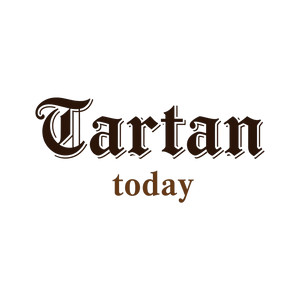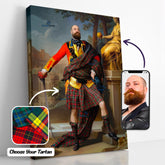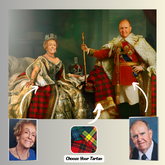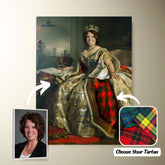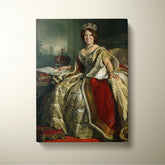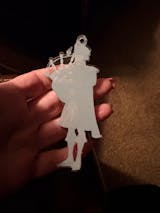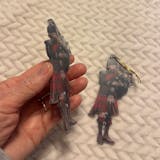-
Personalized Clan Clergy Green Tartan Bagpipe Ornament with Custom Name – Scottish Christmas Tree Decoration ZT70
Personalized Clan Clergy Green Tartan Bagpipe Ornament with Custom Name – Scottish Christmas Tree Decoration ZT70Celebrate your Scottish heritage with this unique wood & acrylic tartan ornament. Perfect as a personalized Christmas decoration or a meaningful gift for friends and relatives on special occasions...- From $19.99 USD
$25.99 USD- From $19.99 USD
- Unit price
- per
Save $6.00 -
Clan Clergy Blue Tartan Clogs Classic JX51 - Clergy Blue Tartan
Clan Clergy Blue Tartan Clogs Classic JX51 Our shoes do run a bit small. We recommend sizing up if you want to be comfortable. Size Guide Product measurements may vary by up to 3~5mm There are two different ways to wear——you can wear it...- $42.25 USD
- $42.25 USD
- Unit price
- per
-
Clergy Blue Tartan
-
Clan Clergy Blue Tartan Table Runner Cotton KN91 - Clergy Blue Tartan
Clan Clergy Blue Tartan Table Runner Cotton KN91 Product detail: Made of durable cotton linen cloth material. Lightweight, durable and could be folded away compactly. Multi-function, stylish decor to any room or table. Gentle hand wash separately in cold water; no shrinkle; no color...- $41.15 USD
- $41.15 USD
- Unit price
- per
-
Clergy Blue Tartan
-
Personalized Clan Clergy Green Tartan Drummer Ornament with Custom Name – Scottish Christmas Tree Decoration FI14
Personalized Clan Clergy Green Tartan Drummer Ornament with Custom Name – Scottish Christmas Tree Decoration FI14Celebrate your Scottish heritage with this unique wood & acrylic tartan ornament. Perfect as a personalized Christmas decoration or a meaningful gift for friends and relatives on special occasions...- From $19.99 USD
$25.99 USD- From $19.99 USD
- Unit price
- per
Save $6.00 -
Personalized Clan Clergy Blue Tartan Drummer Ornament with Custom Name – Scottish Christmas Tree Decoration CM95
Personalized Clan Clergy Blue Tartan Drummer Ornament with Custom Name – Scottish Christmas Tree Decoration CM95Celebrate your Scottish heritage with this unique wood & acrylic tartan ornament. Perfect as a personalized Christmas decoration or a meaningful gift for friends and relatives on special occasions...- From $19.99 USD
$25.99 USD- From $19.99 USD
- Unit price
- per
Save $6.00 -
Personalized Clan Clergy Wilson's Modern Tartan Bagpipe Ornament with Custom Name – Scottish Christmas Tree Decoration FL62
Personalized Clan Clergy Wilson's Modern Tartan Bagpipe Ornament with Custom Name – Scottish Christmas Tree Decoration FL62Celebrate your Scottish heritage with this unique wood & acrylic tartan ornament. Perfect as a personalized Christmas decoration or a meaningful gift for friends and relatives on special...- From $19.99 USD
$25.99 USD- From $19.99 USD
- Unit price
- per
Save $6.00 -
Personalized Clan Clergy Red Reproduction Tartan Bagpipe Ornament with Custom Name – Scottish Christmas Tree Decoration EI33
Personalized Clan Clergy Red Reproduction Tartan Bagpipe Ornament with Custom Name – Scottish Christmas Tree Decoration EI33Celebrate your Scottish heritage with this unique wood & acrylic tartan ornament. Perfect as a personalized Christmas decoration or a meaningful gift for friends and relatives on special...- From $19.99 USD
$25.99 USD- From $19.99 USD
- Unit price
- per
Save $6.00 -
Personalized Clan Clergy Red Modern Tartan Bagpipe Ornament with Custom Name – Scottish Christmas Tree Decoration QM95
Personalized Clan Clergy Red Modern Tartan Bagpipe Ornament with Custom Name – Scottish Christmas Tree Decoration QM95Celebrate your Scottish heritage with this unique wood & acrylic tartan ornament. Perfect as a personalized Christmas decoration or a meaningful gift for friends and relatives on special...- From $19.99 USD
$25.99 USD- From $19.99 USD
- Unit price
- per
Save $6.00 -
Personalized Clan Clergy Red Ancient Tartan Bagpipe Ornament with Custom Name – Scottish Christmas Tree Decoration AG93
Personalized Clan Clergy Red Ancient Tartan Bagpipe Ornament with Custom Name – Scottish Christmas Tree Decoration AG93Celebrate your Scottish heritage with this unique wood & acrylic tartan ornament. Perfect as a personalized Christmas decoration or a meaningful gift for friends and relatives on special...- From $19.99 USD
$25.99 USD- From $19.99 USD
- Unit price
- per
Save $6.00 -
Personalized Clan Clergy of Ulva Reproduction Tartan Bagpipe Ornament with Custom Name – Scottish Christmas Tree Decoration PY41
Personalized Clan Clergy of Ulva Reproduction Tartan Bagpipe Ornament with Custom Name – Scottish Christmas Tree Decoration PY41Celebrate your Scottish heritage with this unique wood & acrylic tartan ornament. Perfect as a personalized Christmas decoration or a meaningful gift for friends and relatives on...- From $19.99 USD
$25.99 USD- From $19.99 USD
- Unit price
- per
Save $6.00 -
Personalized Clan Clergy of Ulva New Reproduction Tartan Bagpipe Ornament with Custom Name – Scottish Christmas Tree Decoration AZ54
Personalized Clan Clergy of Ulva New Reproduction Tartan Bagpipe Ornament with Custom Name – Scottish Christmas Tree Decoration AZ54Celebrate your Scottish heritage with this unique wood & acrylic tartan ornament. Perfect as a personalized Christmas decoration or a meaningful gift for friends and relatives...- From $19.99 USD
$25.99 USD- From $19.99 USD
- Unit price
- per
Save $6.00 -
Personalized Clan Clergy of Ulva New Modern Tartan Bagpipe Ornament with Custom Name – Scottish Christmas Tree Decoration FB33
Personalized Clan Clergy of Ulva New Modern Tartan Bagpipe Ornament with Custom Name – Scottish Christmas Tree Decoration FB33Celebrate your Scottish heritage with this unique wood & acrylic tartan ornament. Perfect as a personalized Christmas decoration or a meaningful gift for friends and relatives...- From $19.99 USD
$25.99 USD- From $19.99 USD
- Unit price
- per
Save $6.00 -
Personalized Clan Clergy of Ulva New Ancient Tartan Bagpipe Ornament with Custom Name – Scottish Christmas Tree Decoration HY90
Personalized Clan Clergy of Ulva New Ancient Tartan Bagpipe Ornament with Custom Name – Scottish Christmas Tree Decoration HY90Celebrate your Scottish heritage with this unique wood & acrylic tartan ornament. Perfect as a personalized Christmas decoration or a meaningful gift for friends and relatives...- From $19.99 USD
$25.99 USD- From $19.99 USD
- Unit price
- per
Save $6.00 -
Personalized Clan Clergy of Ulva Modern Tartan Bagpipe Ornament with Custom Name – Scottish Christmas Tree Decoration AO20
Personalized Clan Clergy of Ulva Modern Tartan Bagpipe Ornament with Custom Name – Scottish Christmas Tree Decoration AO20Celebrate your Scottish heritage with this unique wood & acrylic tartan ornament. Perfect as a personalized Christmas decoration or a meaningful gift for friends and relatives on...- From $19.99 USD
$25.99 USD- From $19.99 USD
- Unit price
- per
Save $6.00 -
Personalized Clan Clergy of Ulva Ancient Tartan Bagpipe Ornament with Custom Name – Scottish Christmas Tree Decoration SM24
Personalized Clan Clergy of Ulva Ancient Tartan Bagpipe Ornament with Custom Name – Scottish Christmas Tree Decoration SM24Celebrate your Scottish heritage with this unique wood & acrylic tartan ornament. Perfect as a personalized Christmas decoration or a meaningful gift for friends and relatives on...- From $19.99 USD
$25.99 USD- From $19.99 USD
- Unit price
- per
Save $6.00 -
Personalized Clan Clergy Green Tartan Bagpipe Ornament with Custom Name – Scottish Christmas Tree Decoration QY14
Personalized Clan Clergy Green Tartan Bagpipe Ornament with Custom Name – Scottish Christmas Tree Decoration QY14Celebrate your Scottish heritage with this unique wood & acrylic tartan ornament. Perfect as a personalized Christmas decoration or a meaningful gift for friends and relatives on special occasions...- From $19.99 USD
$25.99 USD- From $19.99 USD
- Unit price
- per
Save $6.00 -
Personalized Clan Clergy Green Reproduction Tartan Bagpipe Ornament with Custom Name – Scottish Christmas Tree Decoration OA16
Personalized Clan Clergy Green Reproduction Tartan Bagpipe Ornament with Custom Name – Scottish Christmas Tree Decoration OA16Celebrate your Scottish heritage with this unique wood & acrylic tartan ornament. Perfect as a personalized Christmas decoration or a meaningful gift for friends and relatives on special...- From $19.99 USD
$25.99 USD- From $19.99 USD
- Unit price
- per
Save $6.00 -
Personalized Clan Clergy Green Modern Tartan Bagpipe Ornament with Custom Name – Scottish Christmas Tree Decoration ZC66
Personalized Clan Clergy Green Modern Tartan Bagpipe Ornament with Custom Name – Scottish Christmas Tree Decoration ZC66Celebrate your Scottish heritage with this unique wood & acrylic tartan ornament. Perfect as a personalized Christmas decoration or a meaningful gift for friends and relatives on special...- From $19.99 USD
$25.99 USD- From $19.99 USD
- Unit price
- per
Save $6.00 -
Personalized Clan Clergy Green Ancient Tartan Bagpipe Ornament with Custom Name – Scottish Christmas Tree Decoration QI20
Personalized Clan Clergy Green Ancient Tartan Bagpipe Ornament with Custom Name – Scottish Christmas Tree Decoration QI20Celebrate your Scottish heritage with this unique wood & acrylic tartan ornament. Perfect as a personalized Christmas decoration or a meaningful gift for friends and relatives on special...- From $19.99 USD
$25.99 USD- From $19.99 USD
- Unit price
- per
Save $6.00 -
Personalized Clan Clergy Episcopal Modern Tartan Bagpipe Ornament with Custom Name – Scottish Christmas Tree Decoration JA44
Personalized Clan Clergy Episcopal Modern Tartan Bagpipe Ornament with Custom Name – Scottish Christmas Tree Decoration JA44Celebrate your Scottish heritage with this unique wood & acrylic tartan ornament. Perfect as a personalized Christmas decoration or a meaningful gift for friends and relatives on special...- From $19.99 USD
$25.99 USD- From $19.99 USD
- Unit price
- per
Save $6.00
Ex: Your Tartan + Product
Popular Products
Turn Me Royal Personalized Portrait from Your Photo, Custom Tartan. Custom Canvas Wall Art as Gift for Men
- From $32.45 USD
- From $32.45 USD
- Unit price
- / per
Royalty Couple Personalized Portrait from Your Photo, Custom Tartan. Custom Canvas Wall Art
- From $47.45 USD
- From $47.45 USD
- Unit price
- / per
The Queen Personalized Portrait from Your Photo, Custom Tartan. Custom Canvas Wall Art as Gift for Women
- From $32.45 USD
- From $32.45 USD
- Unit price
- / per
Which Clan Are You From?
- Cargill (Clergy) Ancient
- Cargill (Clergy) Modern
- Cargill (Clergy) Weathered
- Clark (Clergy) Ancient
- Clark (Clergy) Modern
- Clark (Clergy) Muted
- Clark (Clergy) Reproduction
- Clark (Clergy) Weathered
- Clergy
- Clergy #2 Ancient
- Clergy #2 Modern
- Clergy #2 Reproduction
- Clergy (Grey) Ancient
- Clergy (Grey) Modern
- Clergy (Grey) Reproduction
- Clergy (Smith) Ancient
- Clergy (Smith) Modern
- Clergy (Smith) Reproduction
- Clergy 01
- Clergy 02
- Clergy 03
- Clergy Blue
- Clergy Blue Tartan
- Clergy Episcopal Modern
- Clergy Green
- Clergy Green Ancient
- Clergy Green Modern
- Clergy Green Reproduction
- Clergy Green Tartan
- Clergy Grey
- Clergy Mackinlay
- Clergy of Ulva Ancient
- Clergy of Ulva Modern
- Clergy of Ulva New Ancient
- Clergy of Ulva New Modern
- Clergy of Ulva New Reproduction
- Clergy of Ulva Reproduction
- Clergy Red Ancient
- Clergy Red Modern
- Clergy Red Reproduction
- Clergy Smith
- Clergy Wilson's Modern
- Mackinlay
- Smith
List Of Tartan
-
Clan A
- Abercrombie Tartan
- Aberdeen Tartan
- Abernethy Tartan
- Adair Tartan
- Adam Tartan
- Ayrshire Tartan
- Agnew Tartan
- Aikenhead Tartan
- Ainslie Tartan
- Aiton Tartan
- Allan Tartan
- Alexander Tartan
- Allardice Tartan
- Allison Tartan
- Anderson Tartan
- Angus Tartan
- Anstruther Tartan
- Arbuthnot Tartan
- Armstrong Tartan
- Arnott Tartan
- Auchinleck Tartan
- Ayrshire Tartan
-
Clan B
- Baillie Tartan
- Bain Tartan
- Baird Tartan
- Balfour Tartan
- Bannatyne Tartan
- Bannerman Tartan
- Barclay Tartan
- Baxter Tartan
- Beaton Tartan
- Bell Tartan
- Belshes Tartan
- Bethune Tartan
- Beveridge Tartan
- Binning Tartan
- Bisset Tartan
- Blackadder Tartan
- Blackstock Tartan
- Black Watch Tartan
- Blair Tartan
- Blane Tartan
- Blyth Tartan
- Borthwick Tartan
- Boswell Tartan
- Bowie Tartan
- Boyd Tartan
- Boyle Tartan
- Brisbane Tartan
- Brodie Tartan
- Brown/ Broun Tartan
- Bruce Tartan
- Buccleuch Tartan
- Buchan Tartan
- Buchanan Tartan
- Burnett Tartan
- Burns Tartan
- Butter Tartan
- Byres Tartan
-
Clan C
- Cairns Tartan
- Calder Tartan
- Callander Tartan
- Cameron Tartan
- Campbell Tartan
- Campbell of Breadalbane Tartan
- Campbell of Cawdor Tartan
- Carmichael Tartan
- Carnegie Tartan
- Carruthers Tartan
- Cathcart Tartan
- Chalmers Tartan
- Charteris Tartan
- Chattan Tartan
- Cheyne Tartan
- Chisholm Tartan
- Christie Tartan
- Clark Tartan
- Clelland Tartan
- Clephan Tartan
- Clergy Tartan
- Cochrane Tartan
- Cockburn Tartan
- Colquhoun Tartan
- Colville Tartan
- Cooper Tartan
- Couper Tartan
- Craig Tartan
- Cranstoun Tartan
- Crawford Tartan
- Crichton Tartan
- Crief District Tartan
- Crosbie Tartan
- Cumming Tartan
- Cunningham Tartan
- Currie Tartan
- Clan D
- Clan E
- Clan F
- Clan G
- Clan H
- Clan I
- Clan J
- Clan K
- Clan L
-
Clan M
- Maitland Tartan
- Malcolm Tartan
- Mar Tartan
- Marjoribanks Tartan
- Maxtone Tartan
- Matheson Tartan
- Maule Tartan
- Maxwell Tartan
- Meldrum Tartan
- Melville Tartan
- Menzies Tartan
- Mercer Tartan
- Middleton Tartan
- Moffat Tartan
- Moncrieffe Tartan
- Montgomery Tartan
- Monypenny Tartan
- Moncreiffe Tartan
- Monteith Tartan
- Morrison Tartan
- Mouat Tartan
- Moubray Tartan
- Mow Tartan
- Muir_More Tartan
- Muirhead Tartan
- Munro Tartan
- Murray Tartan
- Murray of Atholl Tartan
-
Clan Mc/Mac
- MacAlister Tartan
- MacArthur Tartan
- MacAlpine Tartan
- MacAulay Tartan
- MacBain Tartan
- MacBean Tartan
- MacBeth Tartan
- MacCallum Tartan
- MacCraig Tartan
- MacColl Tartan
- MacCorquodale Tartan
- MacDiarmid Tartan
- MacDonald Tartan
- MacDonald of Clanranald Tartan
- MacDonald of Sleat Tartan
- MacDonnell of Glengarry Tartan
- MacDonnell of Keppoch Tartan
- MacDougall Tartan
- MacDowall Tartan
- MacDuff Tartan
- MacEwen_MacEwan Tartan
- MacEdward Tartan
- MacFarlane Tartan
- MacGill Tartan
- MacGillivray Tartan
- MacGregor Tartan
- MacGowan (McGowan) Tartan
- MacHardy Tartan
- MacIan Tartan
- MacInnes Tartan
- MacIntyre Tartan
- MacKay Tartan
- MacKillop Tartan
- MacKellar Tartan
- Mackinlay Tartan
- MacKenzie Tartan
- Mackie Tartan
- MacKinnon Tartan
- MacKintosh / MacIntosh Tartan
- MacLeod Tartan
- MacMillan Tartan
- MacNab Tartan
- MacNaughton Tartan
- MacNeil / MacNeill Tartan
- MacNeil of Colonsay Tartan
- MacNicol Tartan
- MacPhail Tartan
- MacPhee_MacFie Tartan
- MacPherson Tartan
- MacQuarrie Tartan
- MacQueen Tartan
- MacRae Tartan
- MacRow Tartan
- MacSporran Tartan
- MacTaggart Tartan
- MacTavish Tartan
- MacThomas Tartan
- McCorquodale Tartan
- McCulloch Tartan
- McFadzen Tartan
- McGeachie Tartan
- McIver Tartan
- McKerrell Tartan
- Clan N
- Clan O
- Clan P
- Clan R
-
Clan S
- Sandilands Tartan
- Scott Tartan
- Scrymgeour Tartan
- Selkirk Tartan
- Sempill Tartan
- Seton Tartan
- Shaw Tartan
- Shepherd Tartan
- Sinclair Tartan
- Skene Tartan
- Skirving Tartan
- Smith Tartan
- Somerville Tartan
- Spalding Tartan
- Spens Tartan
- Spottiswood Tartan
- Stevenson Tartan
- Stewart Tartan
- Stewart of Appin Tartan
- Stirling Tartan
- Strachan Tartan
- Straiton Tartan
- Strange Tartan
- Strathclyde District Tartan
- Stuart of Bute Tartan
- Sutherland Tartan
- Swinton Tartan
- Clan T
- Clan U W Y
- Request Your Clan
Clan Clergy (Clergy Tartan)
7. The Clergy Tartan: A Symbol of Highland Clergy Attire
The Clergy tartan, also known as the "Priest" tartan, holds significant importance in the world of Scottish Highland attire.
Worn exclusively by clerics, this tartan upholds the principle that Highland clergy should don traditional Highland clothing, albeit without the vibrant colors commonly seen in other tartans.
The Clergy tartan comes in various iterations, including blue and green variations, with all of them staying true to the traditional aesthetic expected of Highland clergy.
In this article, we will delve into the history, symbolism, and modern-day relevance of the Clergy tartan.
7.1 The Origin and Significance of the Clergy Tartan
The Clergy tartan is unique among tartans, as it is considered the sole occupational tartan. Unlike Clan tartans that bear a Clan Chief, the Clergy tartan does not have such a specific association due to its generic nature.
The tartan was specifically designed to be worn by members of the clergy, symbolizing their honored position within the Highland community.
7.1.1 Exploring the Etymological Connection: "Clergy" and "Clark"
The term "clergy," from which the Clergy tartan derives its name, has a linguistic connection with the word "clark." Both terms trace their origins to the Latin word "clericus," which refers to a clergyperson or a scholar.
This linguistic link has led to the adoption of the Clergy tartan by the Clark family, who share a historical connection to the clergy.
7.1.2 The Clark Family Tartan: A Variation of the Clergy Tartan
The Clark family tartan, closely associated with the Clergy tartan, features a more vibrant color palette in comparison.
While the Clark tartan retains the essence and symbolism of the Clergy tartan, it incorporates brighter hues that reflect the evolution and modernization of tartan designs.
This variation highlights the subtle differences within the broader context of tartans and their respective associations.
7.2 The Design and Aesthetic of the Clergy Tartan
The Clergy tartan adheres to the traditional aesthetic expected of Highland clergy. Its design incorporates specific colors and patterns that hold symbolic meaning within the context of religious attire.
Let's explore the design elements and symbolism of the Clergy tartan in more detail.
7.2.1 Color Palette: Subtle Tones for Reverence and Respect
The color palette of the Clergy tartan prioritizes subtlety, reflecting the solemnity and reverence associated with religious attire.
Generally, shades of grey, black, and white dominate the tartan, with occasional hints of blue or green. The subdued tones symbolize the humility and modesty expected of clergy members.
7.2.2 Pattern: Stripes Symbolizing Order and Hierarchy
The pattern of the Clergy tartan typically consists of alternating horizontal stripes of different widths and colors.
Using these stripes, the tartan signifies the order and hierarchy within the clergy's ranks, highlighting the distinct roles and responsibilities associated with different positions.
The intricate arrangement of stripes showcases the precision and attention to detail integral to the clergy's work.
7.2.3 Variations: Exploring Blue and Green Iterations
While the traditional Clergy tartan predominantly features shades of grey, black, and white, variations with blue and green hues also exist.
These iterations add a touch of uniqueness while still maintaining the reverence and respect symbolized by the tartan.
The blue and green variations often incorporate subtle hints of these colors within the main color palette, providing a slightly different aesthetic while remaining true to the essence of the Clergy tartan.
7.3 The Modern Relevance and Cultural Significance
Despite its traditional roots, the Clergy tartan continues to hold cultural significance and relevance in modern times. Let's explore how this occupational tartan remains an important symbol of Highland clergy attire.
7.3.1 Preserving Tradition: Highland Clergy in Traditional Garb
The Clergy tartan enables Highland clergymen to honor their heritage and traditions by wearing traditional Highland attire while performing their religious duties.
By donning the tartan, they pay homage to their Scottish roots and reaffirm their commitment to their religious roles within the community.
7.3.2 Symbol of Authority: Establishing Clerical Identity
The Clergy tartan serves as a visual symbol of authority and identity within the clergy. By wearing the tartan, clerics establish their affiliation and presence, instantly recognizable as respected figures within the Highland community.
This aids in fostering a strong sense of communal identity and unity among clergy members and their congregations.
7.3.3 Connection with History: A Bridge to the Past
The Clergy tartan acts as a bridge connecting the present-day clergy with their historical counterparts.
By wearing a tartan closely associated with the occupation, today's clergy members acknowledge their place in a long line of Highland clergymen who have served their communities throughout the ages.
This connection to history fosters a deeper appreciation for the traditions and values upheld by the clergy.
7.4 FAQs about the Clergy Tartan
Here are some frequently asked questions about the Clergy tartan:
7.4.1 What is the significance of the Clergy tartan?
The Clergy tartan holds significant importance as the sole occupational tartan worn exclusively by clerics. It symbolizes the adherence to tradition, humility, and reverence expected of Highland clergy.
7.4.2 Is the Clergy tartan associated with any specific Clan Chief?
Unlike Clan tartans, the Clergy tartan does not have a specific Clan Chief associated with it due to its generic nature. It is recognized as a tartan worn by the clergy at large rather than a tartan associated with a specific clan.
7.4.3 Are there any variations of the Clergy tartan?
Yes, variations of the Clergy tartan exist, including blue and green iterations. These variations add a touch of uniqueness while staying true to the traditional aesthetic expected of Highland clergy.
7.4.4 What is the connection between the Clergy tartan and the Clark family?
The Clergy tartan and the Clark family tartan share a linguistic connection as both terms, "clergy" and "clark," derive from the Latin word "clericus." This link has led to the adoption of the Clergy tartan by the Clark family.
7.4.5 Can anyone wear the Clergy tartan?
While the Clergy tartan is primarily worn by clergy members, it is not restricted solely to them. Anyone can wear the Clergy tartan as a sign of respect for the occupation and its traditions.
7.4.6 Where can I find more information about the Clergy tartan?
For more in-depth information about the Clergy tartan, you can refer to authoritative sources such as historical books, articles, or reputable websites, including the Scottish Tartans Authority and the Scottish Register of Tartans.
7.5 In Conclusion
The Clergy tartan holds a special place within the world of Scottish Highland attire. As the sole occupational tartan, it symbolizes the adherence to tradition, reverence, and humility expected of Highland clergy.
The various iterations of the tartan, including blue and green variations, cater to individual tastes while staying true to the traditional aesthetic. By wearing the Clergy tartan, clergy members establish their identity, pay homage to their heritage, and connect with their historical counterparts.
The Clergy tartan serves as a visual reminder of the important role played by the clergy in the Highland community, both in the past and in modern times.
- Choosing a selection results in a full page refresh.
